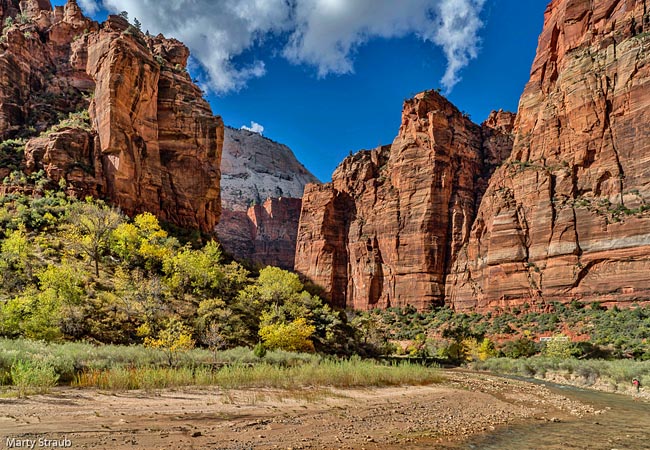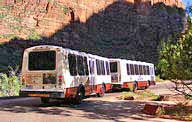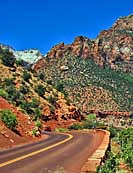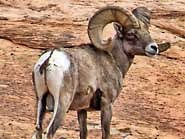|
Scenic USA - Utah Zion National Park |

| Photos by Marty Straub Marty Straub Photography |
Over a long period of time, perhaps as long as 8000 years, people have lived in Zion Canyon. An area now taken up by Zion National Park, each successive group came and went, chased away by a depletion of resources, changes in climate and powerful flash floods.  The same threats still exist today, but canyon residents have been replaced by millions of visitors every year. A few constants at the park are its majestic mountains, patches of contrasting greenery and Utahís deep blue skies.
The same threats still exist today, but canyon residents have been replaced by millions of visitors every year. A few constants at the park are its majestic mountains, patches of contrasting greenery and Utahís deep blue skies.
When Mormon pioneers arrived in the early 1860s, the enormity of these towering cliffs left them in awe and disbelief. Some of the most dramatic canyon walls, standing 2000 to 3000 feet above the valley floor, earned their own unique names. Slowly, word of Zion spread across the United States and throughout the rest of the world, with some people refusing that such a place could exist. Just 50 years after the first settlers arrived, the entire area surrounding Zion Canyon was established as a national monument.
Views of Zionís shear cliff walls are found all along Zion Canyon. So hop aboard the shuttle bus and enjoy these dramatic landmarks in the canyon. One of the first stops from the visitor center is a great place to catch the morning sunrise on a 7540 foot Navajo sandstone peak called the Sundial. Next to it, the Altar of Sacrifice is easily recognized by the "blood stains" that cascade down from the peak. Collectively known as the Towers and Temples of the Virgin, this stop offers one of the park's iconic scenes right behind the museum where park rangers give lectures and talks.
Passed the Carmel Junction,  where park visitors arrive from the east, the free shuttle bus service takes over any trip into the canyon. Shuttles depart every 15 minutes when the park gets busy, and you may get on and off as often as you like. The next stop is the Court of Patriarchs, a reference to three generations of Israelites, e.g., Abraham, Isaac and Jacob. Back in 1916, Methodist Minister Frederick V. Fischer applied many religious names to the areaís prominent landmarks.
where park visitors arrive from the east, the free shuttle bus service takes over any trip into the canyon. Shuttles depart every 15 minutes when the park gets busy, and you may get on and off as often as you like. The next stop is the Court of Patriarchs, a reference to three generations of Israelites, e.g., Abraham, Isaac and Jacob. Back in 1916, Methodist Minister Frederick V. Fischer applied many religious names to the areaís prominent landmarks.
Next up is Zion Lodge and the Emerald Pool Trails. The lodge is the only place inside the park to spend the night and buy something to eat. The Zion Lodge was completed in May 1925 and was later complimented with a series of stand-alone cabins. It's unfortunate, but the original lodge reduced to ashes in 1966. Although the lodge was rebuilt within 100 days, it lacked the rustic look that's typical of a national park lodge. A 1990 remodel returned the lodge to its historic appearance.
The Grotto, Weeping Rock, Big Bend and Temple of Sinawava follow, but many park visitors are eager to see Angels Landing and the Zion Narrows. While no wings are needed to see Angels Landing, some strong legs and good climbing shoes are essential. The Riverside Walk, beyond the Temple of Sinawava, leads into the Narrows where all park visitors are tempted to look up-canyon into the Narrows. Partial hikes into  the Narrows are common. A hike in the Virgin River, with the right footwear, is a rewarding experience. The hike as far as Big Spring (no permit required) is a strenuous, ten-mile round trip, and an all-day adventure.
the Narrows are common. A hike in the Virgin River, with the right footwear, is a rewarding experience. The hike as far as Big Spring (no permit required) is a strenuous, ten-mile round trip, and an all-day adventure.
There are two more sections of Zion National Park which offer a more relaxed atmosphere than the extremely popular Zion Canyon. The Kolob Terrace Road traverses both the Lower and Upper Kolob Plateau as it passes six hiking trails on the way to the Kolob Reservoir. This is a more primitive drive without services, and is usually closed from November to June because of inclement weather. In the western section of the park, accessed from I-15, Kolob Canyons features more hiking trails. Here on the lengthy La Verkin Creek Trail, hikers are rewarded with views of the massive Kolob Arch. The Kolob Arch is one of the world's largest freestanding arches, measuring 287 feet across its opening. For casual sightseers, the Kolob Canyon Road makes for a pleasant, unhurried drive on the way to Kolob Canyon Viewpoint. Who knows, you may be enticed to put on your hiking shoes and experience the "quiet side" of Zion.
Area Map
Canyon Trails and Map
NPS Park Map

|
Additional Area Attractions |
|
Copyright © 2021 Benjamin Prepelka
All Rights Reserved
